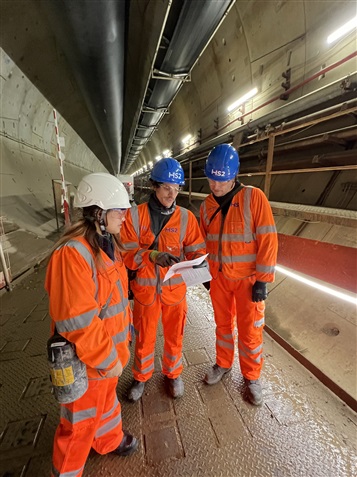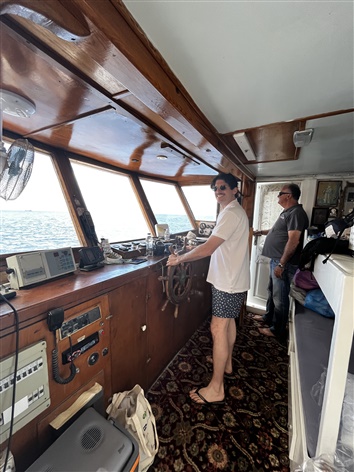The winner of the Sir Henry Royce Medal is laying the foundations of a firm future for decarbonised concrete
Fragkoulis Kanavaris is the 2024 winner of the IET's Sir Henry Royce Medal for his work in lowering the carbon content of concrete. He is Arup's global Concrete Materials Specialist Lead and the organisation's global lead for Concrete Decarbonisation. He graduated with a Master's in Civil and Structural Engineering at the University of Liverpool in 2012 before pursuing a PhD at Queen's University, Belfast, in 2017.
After a brief spell at the Universidade do Minho as a Visiting Research Fellow, he joined Arup.
The fascination with concrete is something Fragkoulis traces to his father. "I have to give part of this to my father because he is also a structural engineer (retired). When I was still at school, I used to join him on construction sites, and he was also excited about concrete and its complexities as a material."
Impressions of carbon
Concrete is a carbon-intensive material, accounting for approximately 8% of global CO2 emissions. It is carbon intensive because its main ingredient mainly uses heated limestone alongside clays and other minor constituents. Simply put, the limestone goes through the process of calcination, which involves heating it to 1450°C. The end product is Portland Cement. CO2 is produced by the energy needed to create heat and by chemical reactions during the process.
Reducing the CO2 footprint of concrete means reducing the quantity of Portland cement it uses. The problem, says Fragkoulis, is that "Portland cement is a very well-performing material for concrete. It is the substance that binds everything together in concrete, and reducing it can adversely affect the performance of the concrete."
In the mix
There is a pressing need to reduce that scale of carbon output, but the versatility and affordability of concrete means we will not stop using it to construct buildings and infrastructure. Consequently, we must find ways to reduce and eventually remove its embodied carbon. One method is to reduce or eliminate Portland cement in concrete and replace it with less energy-intensive materials such as waste from industrial operations, tunnelling or mining operations.
 Fragkoulis says, "In some situations, it is possible to reduce the carbon body of concrete by between 70% and 80% depending on the application, which is substantial. To achieve this, we use innovative methods of design and specification to push the boundaries of existing industry practice. It varies between 20% and 60%, particularly in the UK."
Fragkoulis says, "In some situations, it is possible to reduce the carbon body of concrete by between 70% and 80% depending on the application, which is substantial. To achieve this, we use innovative methods of design and specification to push the boundaries of existing industry practice. It varies between 20% and 60%, particularly in the UK."
The UK leads the way in reducing carbon in concrete. Spreading these gains more evenly around the world is a challenge - because Europe and the UK have access to potentially low-carbon virgin materials to produce concrete, which are less readily available in the Global South. The next step is to find and exploit newer low carbon materials sources that people in places such as Africa and South Asia can successfully use.
Cracking the Portland cement problem
Reducing carbon is a broad area with activities in cement science, concrete science, and their corresponding industries. Carbon capture and storage is an option, but an option that requires significant capital investment. This cost moves the decarbonising focus to other ideas. A transitional step involves reducing the volume of Portland cement and combining it with different materials.
The industry is testing concretes that do not rely on Portland cement but on different chemistries and technology. Whilst these are scientifically exciting, they could take years to scale up. There is a short time frame to balance scientific enthusiasm and practicality and get it right for the industry.
The role of supplementary cementitious materials (SCM) is to reduce and replace Portland cement. Traditionally, they have been by-products from other industries - fly ash from coal-fired power stations and ground granulated slag produced within blast furnaces used in iron and steel production.
As these industries are subject to carbon reduction strategies, their by-products will become harder to source. As a result, we must find new sources of supplementary cementitious materials (SCM).
A pillar of Roman strength
As these industries are subject to carbon reduction strategies, their by-products will become harder to source. As a result, we must find new sources of supplementary cementitious materials (SCM).
Natural pozzolans would be one new source, named after the Italian city of Pozzuoli, where the ancient Romans sourced a major ingredient in their concrete - volcanic ash originating in Mount Vesuvius.
Materials, such as pumicites and tuffs, originate in the magma chamber of a volcano. They could be opaline cherts, shales, and clays, which also have magmatic origins. Once out of the ground, the pozzolan is milled or pounded into pellets or a powder. When mixed into concrete, these pellets or powders react with calcium hydroxide to produce a compound with cementitious properties.
Not all pozzolans are naturally occurring. Fly ash and silica fume from silicon smelting, burned organic matter (rice husk ash would be one example), and metakaolin are examples of artificial pozzolans.
On aggregate
 Mining waste and limestone could be other sources of SCMs. There is research investigating more varied materials to perform this role, such as bauxite residue and recycled glass. While contemplating alternative SCMs, another line of thought might include the scale of our use of concrete.
Mining waste and limestone could be other sources of SCMs. There is research investigating more varied materials to perform this role, such as bauxite residue and recycled glass. While contemplating alternative SCMs, another line of thought might include the scale of our use of concrete.
The consumption of concrete is second only to the global consumption of water. Put another way, there are some four billion cubic metres of concrete produced each year. There are not enough SCMs available to meet this demand.
Calcined clay is another short-term solution to the demand for SCMs. Extracting clays has little difficulty, given their natural abundance,
and converting them into SCMs is straightforward.In the UK, one source of this is the High Speed 2 (HS2) – or rather, the London Clay excavated as part of its construction. Once it is out of the ground, converting it into calcined clay creates a usable SCM that can reduce concrete's embodied carbon content by up to 70%.
It also shrinks the cost of transporting and disposing of the clay, the resulting concrete, and thus the project itself.
Carrying the weight
Fragkoulis says the concrete and cement industries are under pressure to decarbonise their products and do so affordably, both of which are absorbing and intricate challenges to meet.
"Our role as engineers and scientists is to push the boundaries of what is currently possible while maintaining safety and robustness in our designs so that we can implement novel technologies. To do so, we need to develop a rigorous plan for testing and implementing those technologies. And we need to work with all parties across the value chain - not only engineers and scientists, but also contractors, manufacturers, clients, and public authorities."
Share your thoughts!
What do you think are the main barriers to the widespread adoption of low-carbon concrete in the construction industry? Share your thoughts in the comments below.
About the Sir Henry Royce Medal
Sir Henry Royce (1863–1933) was an English engineer and co-founder of Rolls-Royce. Despite limited formal education, he excelled in engineering, starting with electric fittings and later building his first car in 1904. This led to the founding of Rolls-Royce with Charles Rolls. The company became famous for high-quality cars and aircraft engines. Royce’s dedication to engineering excellence earned him numerous accolades, including an OBE and a baronetcy. His legacy endures in the prestigious Rolls-Royce brand.
The IET presents the Sir Henry Royce Medal to early career professionals for their exceptional contribution to science, technology, and engineering within the last three years.